Parradee Kietsirikul
By Rob Isbitts
I considered telling this “story” via technical charts: help and resistance ranges, buying and selling ranges, technical indicators which might be traditionally very overvalued, and so on. However there’s loads of time for that in future articles. As an alternative, here is a unique solution to talk the identical conclusion:
Future inventory market returns could disappoint many buyers for years to come back
This isn’t a prediction. It’s, nonetheless, a excessive chance, primarily based on my many years of learning each markets and market members (I used to be an funding advisor for 27 years, and have written within the public sphere for over 20 years). You see, bushes do not develop to the sky. And inventory market returns do not usually average over time…they crash. That sequence can take a number of years. But the present group of market members could not have a way of historical past, apart from the flash-crash of 2020 and the single-year bear market of 2022. As we make investments, “old-timers” may say…however wait, there’s extra. Here is the extra for you. I hope it helps deliver perspective that aids in understanding the place we’re in historical past, and what may come subsequent. Not solely in 2023, however over the following a number of years, even the following decade.
A performed a analysis examine that sought to reply the next questions concerning the S&P 500 Index:
1. Is a down yr in 2022 such an enormous deal?
2. What does inventory market historical past inform us about one down yr that follows a really sturdy multi-year interval?
3. Is market historical past actually a very good information?
Methodology
I went again to 1975, as a way to get sufficient of a pattern dimension of annual returns. I transformed that annual information into “rolling” intervals of 5, 10 and 15 yr. It is a long-term examine, although as you will note, it has some critical instant implications for some buyers.
I used worth returns, not complete returns. That’s, I excluded dividends. I needed to give attention to the worth adjustments, since dividends on shares are traditionally low and have been so for a very long time. Dividends could certainly be a much bigger consider returns going ahead, however I didn’t wish to put that bias on this backward-looking overview. I will be writing a lot about dividends within the months forward. I’m, in spite of everything, the founding father of Fashionable Earnings Investor.
Punch Traces
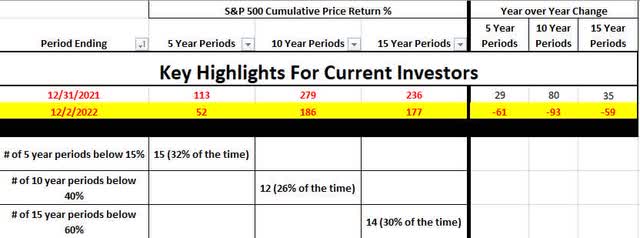
Fashionable Earnings Investor (Rob Isbitts). Supply for all information: YCharts
The chart above is for buyers who simply need the “punch traces” right here. The data beneath will get an increasing number of granular. So, take your decide on how far down you wish to learn. I will repeat the three questions from above and ship my solutions.
1. Is a down yr in 2022 such an enormous deal?
Sure. As a result of this yr has been pushed by a real sea change. Inflation, greater rates of interest, and the Fed maintaining everybody on their toes (or, considered one other approach, complicated the heck out of all of us), through a constantly-changing rhetoric. And, as my examine exhibits, inventory market investing tends to be extra feast versus famine, with far much less in between. In that chart above, discover these bins on the backside. These summarize the practically 50 years of annual return information that I spotlight right here however present intimately in a desk on the backside of this text.
Practically 1/3 of the time, the S&P 500 has produced a worth return of lower than 15%. It is a cumulative return determine, not annualized. So, a return of lower than 3% a yr for five years, excluding dividends. That is beneath the present inflation price by a mile. And it’s prone to frustrate the heck out of at the moment’s extra immediate-gratification investor plenty. That is what’s irritating many people market veterans proper now: that the market has not flushed itself out, so {that a} true, new bull market in shares can start. As an alternative, we’ve this infinite dance, with rubbish shares popping on any indicators of life it interprets from the Fed. This obsession will not be long-term wholesome. As I see it, one down yr isn’t any massive deal to many buyers. Give them a second, and it’ll begin to infect the psyche.
And that is what this information tells me. As a result of as soon as the assumed-to-be ceaselessly good occasions begin to fade away, that boiling frog analogy begins to seep into market psychology. That’s, the market’s feelings go from “I am OK with a drop in my inventory portfolio, as a result of it at all times comes again sturdy.” This chart exhibits that’s false, historically-speaking. As a result of not solely do we’ve the information that exhibits that 1/3 of the time you earn a meager return over 5 years for taking all of that market danger. Whenever you look out 10 and 15 years, you see that mediocre returns could be contagious. I selected a 10-year worth change of 40%, and a 15-year worth change of 60% because the dividing line between “I am Happy with that” and “why am I bothering to spend money on the inventory market anymore.”
As you possibly can see, round 25-30% of the time, you possibly can look again at your S&P 500 Index fund and what have you ever earned, excluding dividends? Lower than 4% a yr in case you use a easy common, and extra like 3% or so in case you use a return compounding method. There was a time when buyers not solely stated they had been “long-term buyers,” they meant it. We’ve but to see if the fashionable investor is that affected person. Name me skeptical. That is why I’ve devoted the remainder of my profession to pondering exterior of this field. As a result of somebody has to.
2. What does inventory market historical past inform us about one down yr that follows a really sturdy multi-year interval?
That these weaker time frames of 5,10 and 15 years have a tendency to come back in bunches. And, that they have an inclination to start out with a single down yr that follows a traditionally ebullient interval for the S&P 500. You already know, like we’ve proper now. Right here is the 5-year worth return of the S&P 500 going again a really great distance. Discover that when that 5-year determine has crossed over 100% after which begins to fade down, that is often the beginning of a pattern.
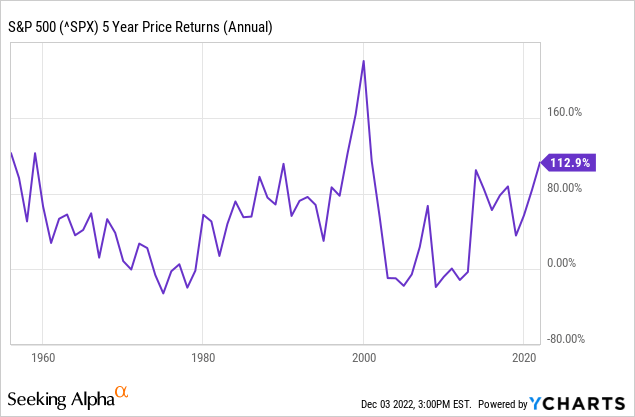
S&P 500 5-year rolling (YCharts and In search of Alpha)
Now, have a look again on the desk above. That yellow-highlighted space tells us that, barring a miracle run the following few weeks of December, that 5-year rolling return goes to crash from 113% to lower than half of that. Traditionally, that is how the longer-term pattern change begins.
I will additionally add this: it’s uncommon that the 5, 10 and 15-year returns all fall in the identical yr. When it does, it often means we’re in the course of a much bigger deal than one down yr that merely revives when the following yr begins. See the “busy” historical past chart on the backside of this text for that element. Or, in case you desire, visualize it by trying on the rolling 10-year and 15-year worth charts for the S&P 500 right here.
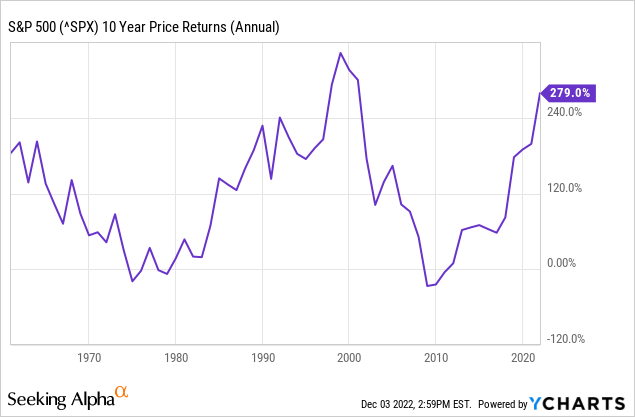
S&P 500 10-year rolling (YCharts and In search of Alpha)
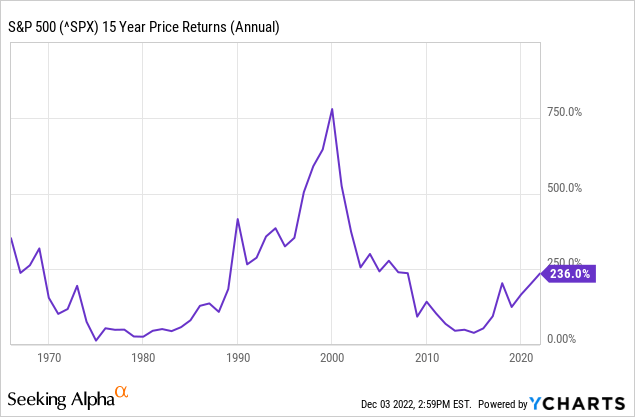
S&P 500 15-year rolling (YCharts and In search of Alpha)
3. Is market historical past actually a very good information?
We’re about to seek out out. Years in the past, all of that Fed rhetoric and 24/7 markets protection that did not matter as a result of most individuals weren’t buyers. And, we did not have 24/7 protection. You regarded on the Wall Road Journal or your native newspaper to seek out out what occurred yesterday.
We didn’t have the military of self-directed merchants and buyers we’ve now. Whereas the acceptance of investing within the mainstream is nice to see, it additionally calls into query what nonetheless works.
Then, immediate communication got here on the scene, and gave the funding enterprise its greatest “maintain my beer” second ever. You need up-to-the-minute? Now you could have all you possibly can deal with. And albeit, greater than most can deal with, primarily based on how poorly many buyers have performed this yr, the primary time of their investing lives that the wind was not at their again.
Subsequent yr, we should always discover out much more. 2022 will both be an anomaly in a continued secular bull market, or it’ll conform extra to what has occurred prior to now. My hunch is that 2023 will probably be one other down yr for the inventory market. I will have a lot extra to say about that as we transition from 2022 to 2023. However for now, my bottom-line is that regardless of the entire trendy changes to how markets, investing and communication work, there may be nonetheless a component of human emotion and thought conduct patterns that by no means goes away. That is the case, regardless of how a lot a number of massive corporations attempt to shift how our brains operate.
Conclusions (for now)
This inventory market is in bother. One down yr is probably going not sufficient to purge the last decade of straightforward cash and the funding market hypothesis it has wrought. We have gone from the times of buy-and-hold to 2022, the place you possibly can commerce S&P 500 choices contracts that expire any buying and selling day of the yr. That is progress…of some kind, anyway. However as I see it, it’s all a part of the risk-unwind that previous investing eras train us, however which might be largely in denial as a calendar yr decline within the inventory market concludes.
What can change this course? If the market has shifted to a everlasting state of optimistic vibes. I do know the previous fairly effectively. I do not know if my tackle the current is correct, but. I believe we’ll all discover out quickly the place that is going. That’s, whether or not historical past is the perfect information, a very good information or has been rendered irrelevant.
Lastly, here is that extra detailed chart to again up my figures and opinions above. Take pleasure in.
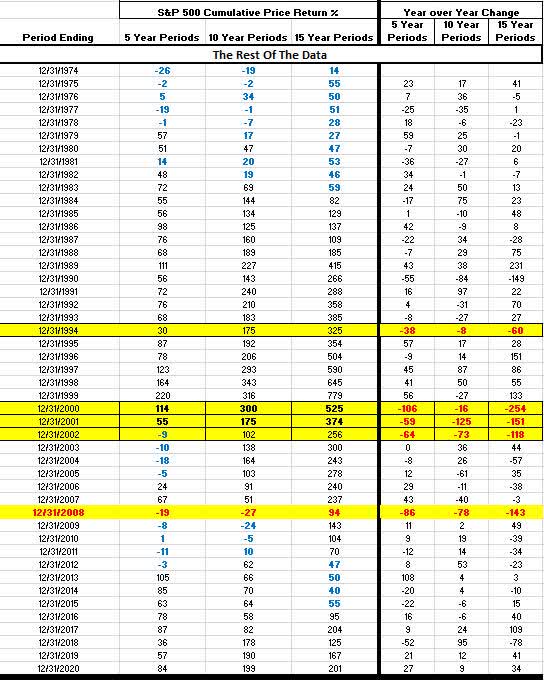
Fashionable Earnings Investor (Rob Isbitts). Supply for all information: YCharts